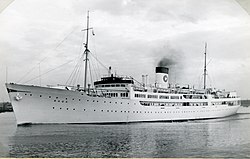Nessebar (ship, 1946)
|
The saga in 1952
|
||||||||||||||||||||||
|
||||||||||||||||||||||
|
||||||||||||||||||||||
|
||||||||||||||||||||||
|
||||||||||||||||||||||
|
||||||||||||||||||||||
The Nessebar (bulg. Несебър ) was a passenger ship built in 1946 , which was first operated as a Saga under the Swedish flag until 1956 , then under the French flag until 1964 and under the Bulgarian flag until it was scrapped in 1975.
Construction and technical data
Shortly before the Second World War, the Swedish shipping company Svenska Lloyd ordered a new passenger ship for its North Sea service from the Götaverken shipyard in Gothenburg in 1939 . In summer the ship was to be used on the Gothenburg - London route and in winter for cruises . As a subcontract, the shipyard awarded the construction contract for the hull to Lindholmens Varv , also based in Gothenburg , where the ship was launched as a saga on October 10, 1940 without a machine . Further construction was stopped due to the war and resumed after the war. The completion and delivery took place in May 1946.
The ship was 128.3 meters long, 16.9 meters wide and had a draft of 9.0 meters. It was measured with 6458 GRT or 3498 NRT and had a load capacity of 2150 tons. Four eight-cylinder Götaverken diesel engines generated 6,700 hp and enabled a speed of 18.5 knots with one screw . Their partially air-conditioned accommodations offered space for 160 passengers in the first, 80 in the second and 100 in the third class, and a further 60 portable berths were available in the summer months. The crew consisted of 400 men.
history
Swedish saga
For Svenska Lloyd, it was the second ship with this name that had previously been carried by a passenger ship built in 1909 and operated from 1916 to 1929. The new saga started on May 20, 1946 on its maiden voyage from Gothenburg to London and was until then the largest ship that docked in the City of London. In autumn, the two older ships Britannia and Suecia replaced the Saga in the North Sea service, which then opened the cruise season to the Canary Islands , Casablanca , Spain and Portugal . She had previously visited Bergen and the Hardangerfjord in Norway . In the long run, the saga was too big for the North Sea service and the operating costs of the ship too high, so the shipping company sold the saga to France in December 1956.
French Ville de Bordeaux
The buyer of the ship was the Compagnie Générale Transatlantique , which named the ship Ville de Bordeaux and had a new diesel engine from Burmeister & Wain installed. The shipping company initially used the ship on the route between Bordeaux and Casablanca for a year until it was replaced by the Maroc in 1957 . The Ville de Bordeaux then drove on the routes to North Africa and the Atlantic Islands. In 1963 it started operating on its last line and operated between Marseille and Corsica for a year before the shipping company took it out of service and sold it again.
Bulgarian Nessebar
The buyer was the Bulgarian state shipping company Navigation Maritime Bulgare , which took over the ship on February 27, 1964 in Marseille. To complement the beginning Bulgarian tourism with new hotels for western visitors, the company Balkanturist was looking for a cruise ship to generate additional western foreign currency , which was reinforced in 1967 by the Varna . For the shipping company, it was the first larger passenger ship to be used beyond coastal shipping . The new acquisition was named Nessebar after the city of the same name Nessebar . While still in Marseille, the ship was adapted to the new requirements and converted for 319 first and second class passengers. The crew now consisted of 129 men. The shipping company initially used the Nessebar for trips to Istanbul , and later also to Port Said . In the first three months alone, the Nessebar carried almost 6,000 passengers from 18 countries. The ship was very popular and was nicknamed the "White Swan".
With the reorganization of the Bulgarian shipping companies in 1972 , the Nessebar switched from Navigation Maritime Bulgare to the newly founded Balkanship - a subsidiary of Balkanturist, to which the country's passenger ships were now subordinate. In 1975 the operation became unprofitable and the ship was taken out of service in the same year. On December 25th, the Nessebar reached the scrapping yard in Split .
literature
- Ambrose Greenway: Cross Channel and Short Sea Ferries. An Illustrated History . Seaforth Publishing, Barnsley 2014, ISBN 978-1-84832-170-0 , pp. 145 (English, limited preview in Google Book Search [accessed June 22, 2020]).
Web links
- Saga (2) at simplonpc.co.uk (photos launched and as Saga ), accessed on June 20, 2020
- Svenska Lloyd / Swedish Lloyd at theshipslist.com , access: June 20, 2020
- Navibulgar news December 2012 - January 2013 (History of the shipping company) (Bulgarian), accessed June 20, 2020
- Nessebar or White Swan? at morskivestnik.com (Bulgarian), accessed June 20, 2020
- Photo and additional information about Nessebar at morskivestnik.com (Bulgarian), accessed on June 20, 2020
- Half a century ago: Arrival of the "Nessebar" in Varna at morskivestnik.com (Bulgarian), accessed on June 20, 2020
- M / S Saga at faktaomfartyg.se , access on June 20, 2020
Individual evidence
- ↑ a b c d e Greenway, p. 145
- ↑ Svenska Lloyd / Swedish Lloyd at theshipslist.com
- ↑ Navibulgar news December 2012 - January 2013 (history of the shipping company), p. 28
- ↑ Nessebar or White Swan? at morskivestnik.com
- ↑ Photo and additional information about the Nessebar at morskivestnik.com
- ↑ Half a century ago: Arrival of the "Nessebar" in Varna at morskivestnik.com
